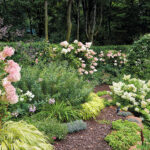Hydrangeas are a popular and versatile plant that can add beautiful color and texture to any landscaping design. Their large, showy blooms and lush, green foliage make them a favorite among gardeners looking to create a stunning outdoor space. However, like any plant, hydrangeas require proper care and maintenance to thrive in their environment.
When it comes to landscaping with hydrangeas, one of the most important considerations is choosing the right location. Hydrangeas prefer partial shade, meaning they thrive in areas that receive morning sun and afternoon shade. Planting them in full sun can cause their blooms to wilt and their leaves to burn, while planting them in full shade can lead to leggy growth and decreased flower production.
In terms of soil, hydrangeas prefer well-draining, nutrient-rich soil. Amending the soil with organic matter, such as compost or peat moss, can help improve drainage and provide essential nutrients for healthy growth. Hydrangeas also benefit from regular watering, especially during hot, dry periods. A thick layer of mulch around the base of the plant can help retain moisture and regulate soil temperature.
Pruning is another important aspect of landscaping with hydrangeas. Different varieties of hydrangeas require different pruning techniques, so it is important to know the specific needs of the plants in your garden. Generally speaking, most hydrangeas benefit from annual pruning to remove dead or damaged branches and encourage new growth. Pruning should be done in late winter or early spring before new growth begins.
Adding additional nutrients to the soil can help promote healthy growth and vibrant blooms. Fertilizing hydrangeas with a balanced, slow-release fertilizer in the spring can provide the nutrients they need to thrive throughout the growing season. Over-fertilizing can lead to excessive foliage growth at the expense of flowers, so it is important to follow the recommended guidelines for fertilizing hydrangeas.
In conclusion, landscaping with hydrangeas can add beauty and elegance to any outdoor space. By choosing the right location, providing proper soil conditions, regular watering, appropriate pruning, and fertilizing, you can ensure your hydrangeas thrive and produce stunning blooms year after year. With the proper care and maintenance, hydrangeas can be a standout feature in your landscape design.
















